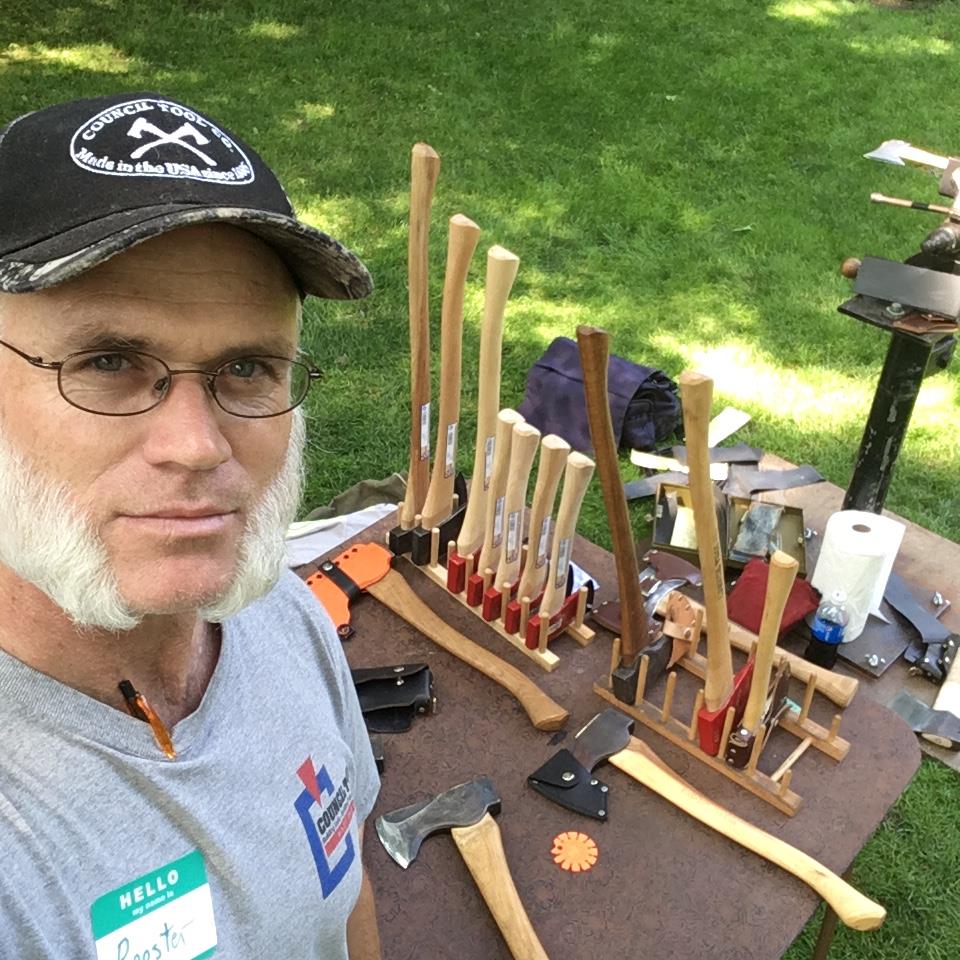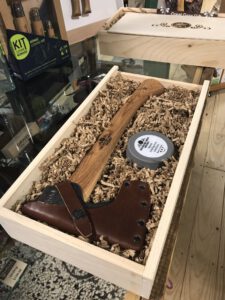
Andrew Romero doesn’t take an axe when he goes backpacking.
“I like to go light,” says Andrew, a sales associate in our Greensboro store in the Westover Gallery of Shops. “I go for weekend trips and I usually don’t build a fire. And I’ve got a 55-liter pack, so my space is limited. So no, I wouldn’t take an axe.”
At least, that’s what we says at the beginning of our conversation. Then he starts talking about the line of Gränsfors Bruk axes from Sweden, where axes are used for everything from building homes (there’s a specific axe for felling trees, another for notching joints, a third for fine carpentry), to recreation (axe throwing is a longtime national pastime). A longtime knife aficionado, Andrew is relatively new to the world of axes, but he’s become a fast fan.
Unfortunately, the only Gränsfors Bruk Andrew can show is the multipurpose Wildlife Axe: the rest of his inventory has been temporarily depleted by holiday demand. But that’s OK because the Wildlife Axe is Gränsfors Bruk’s all-purpose axe, good for a little of everything.
Hand axes, hand crafted
If you’re just getting into axes, this is the axe to get, Andrew advises. “It’s got a secretive alloy steel, not to hard, not to soft.” The secret, according to Gränsfors Bruk’s website, starts with using only recycled scrap metal.
“One of the really cool things about these axes is that each one is hand-crafted by a specific craftsman,” says Andrew. He pulls a model from the display case and points to the axe head: next to the Gränsfors Bruk logo are two initials: “DG.” “Each axe is signed by the person who made it.” (Nice work, Daniel Gräntz!)
“And there’s the handle,” he says. Running his index finger down the length, he adds, “The age lines should run lengthwise down the handle. It makes the axe stronger.” Same philosophy that’s behind a wood baseball bat (same material, too: both are made of dense, strong hickory).
The Axe Book

Andrew picks up a small booklet that I soon learn is something of an Axe bible. It’s titled simply “The Axe Book,” and it covers everything axe, from the various types of axes (Hunter’s and Carpenter’s are among the 10 listed), to the parts of an axe (among other things, an axe has a head, a shoulder, a belly, a cheek and a throat), to which axe is best for you (if you plan on squaring logs, the Swedish Broad Axe is your best bet).
“Sometimes when it’s slow in the store, I’ll read The Axe Book,” Andrew confides.
It’s easy to see why. The Axe Book not only discusses the axes it makes and sells, it goes over axe history, it has a succinct and nicely illustrated section on how a Gränsfors Bruk axe is made, it goes over proper techniques for everything from limbing a log to splitting firewood (and how to properly store the result) and it talks about the company: though based in Sweden, it also has a facility in Summerville, S.C.
A North Carolina-made axe
The Southeast’s connection to cool tools is underscored by the other line of axes we carry, from Lake Waccamaw, N.C.-based Council Tool. Council Tool goes back even farther than Gränsfors Bruk, dating to 1886, when John Pickett Council, frustrated by the tools available for harvesting turpentine, he began making his own. Their line has grown to meet a range of other needs, from felling trees (the Michigan Railsplitter) to clearing trail (the Pulaski), among other things.
“Council is a slightly less expensive way to get into axes,” says Andrew.
20-year guarantee

The Gränsfors Bruk axes come with a 20-year guarantee.
“In a way,” says Andrew, “that might be better than a lifetime guarantee. It says, ‘We know this axe is good for at least 20 years. The rest is up to you.’”
That means the axe needs — deserves — your occasional attention. It needs periodic sharpening, it should be cleaned promptly, it shouldn’t be left in a puddle or other wet environment.
“These are definitely axes for using,” Andrew says, “not collecting. Although there are axe collectors out there. People will watch for axes with a certain forger’s initials.”
Back to backpacking
The more Andrew waxes about axes the more he warms to the idea of taking one backpacking.
“The head only weighs a pound,” he says. “And look at this: it comes with a sheath, that attaches to your belt. So it’s not like more weight in your pack; heck, I probably carry a pound of change and keys in my pocket.” Maybe taking an axe isn’t such a bad idea.
Store Manager Rob Arends drops in on the conversation about this time. Rob, you’re an avid backpacker: do you take an axe when you backpack?
He smiles. “I grew up in New Hampshire, and we had a wood stove to heat the house. We’d fire it up every morning, and when we got home from school the house would be down to 45 degrees, so we’d fire it up again. Every summer I had to chop six cords of wood for the winter.
“I think I’ve done all the chopping I’m gonna do.”
* * *
For more on Council Tool axes, go here
For more on Gränsfors Bruk axes, go here
